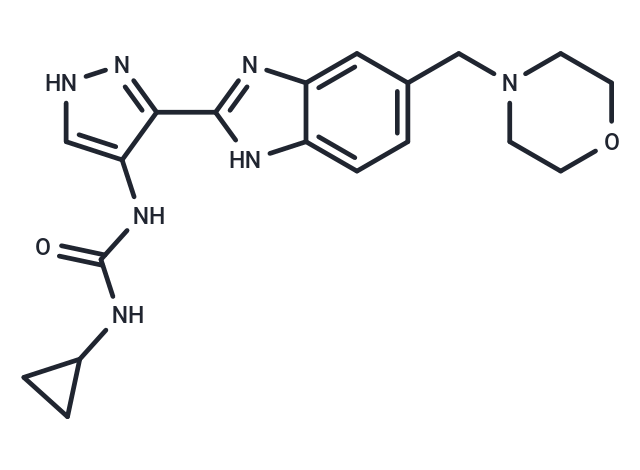Shopping Cart
- Remove All
 Your shopping cart is currently empty
Your shopping cart is currently empty

AT9283 (J-504568) is an effective multi-targeted inhibitor of JAK2(IC50=1.2 nM) and JAK3(IC50=1.1 nM), Aurora A, Aurora B and Abl(T315I).

| Pack Size | Price | Availability | Quantity |
|---|---|---|---|
| 1 mg | $39 | In Stock | |
| 2 mg | $55 | In Stock | |
| 5 mg | $96 | In Stock | |
| 10 mg | $173 | In Stock | |
| 25 mg | $315 | In Stock | |
| 50 mg | $525 | In Stock | |
| 100 mg | $762 | In Stock | |
| 1 mL x 10 mM (in DMSO) | $98 | In Stock |
| Description | AT9283 (J-504568) is an effective multi-targeted inhibitor of JAK2(IC50=1.2 nM) and JAK3(IC50=1.1 nM), Aurora A, Aurora B and Abl(T315I). |
| Targets&IC50 | JAK2:1.2 nM, JAK3:1.1 nM |
| In vitro | In mice bearing HCT116 human colorectal carcinoma xenografts, AT9283 (15-20 mg/kg) was capable of inhibiting tumor growth. |
| In vivo | In HCT116 cells, AT9283 inhibits Aurora B kinase activity with an IC50 value of 30 nM, leading to a polyploid phenotype and concurrently suppressing colony formation. Moreover, AT9283 significantly inhibits a range of kinases, including Aurora A (IC50=3 nM), Aurora B (IC50=3 nM), JAK3 (IC50=1.1 nM), JAK2 (IC50=1.2 nM), and Abl (IC50=4 nM). |
| Kinase Assay | Aurora A and Aurora B Kinase Assays: Assays for Aurora A and B are performed in a DELFIA format. Aurora A enzyme is incubated with AT9283 and 3 μM cross-tide substrate (biotin-CGPKGPGRRGRRRTSSFAEG) in 10 mM MOPS, pH 7, 0.1 mg/mL BSA, 0.001% Brij-35, 0.5% glycerol, 0.2 mM EDTA, 10 mM MgCl2, 0.01% β-mercaptoethanol, 15 μM ATP, and 2.5% DMSO. Aurora B enzyme is incubated with AT9283, 3 μM of the above substrate in 25 mM Tris, pH 8.5, 5 mM MgCl2, 0.1 mg/mL BSA, 0.025% Tween-20, 1 mM DTT, 15 μM ATP, and 2.5% DMSO. Reactions are allowed to proceed for 60 minutes and 45-90 minutes for Aurora A and Aurora B, respectively, before quenching with EDTA. The reaction mixtures are then transferred to a neutravidin-coated plate, and phosphorylated peptide is quantified by means of a phospho-specific antibody and a europium labeled secondary antibody using time-resolved fluorescence (excitation, 337 nm; emission, 620 nm). IC50 values for the control compounds are 92 nM (Aurora A assay) and 17 nM (Aurora B). |
| Cell Research | HCT 116 cells are cultured in DMEM + 10% FBS + GLUTAMAX I. Black 96-well flat-bottomed (clear) tissue culture treated plates are seeded in 200 μL of medium and incubated for approximately 16 hours at 37°C in a humidified atmosphere of 5% CO2 in air. Cells are treated with test compound at nine different concentrations (spanning 1 nM to 10 μM, plus DMSO vehicle control) and then incubated for 72 hours. Polyploidy morphological observations of the cells are then noted. The concentration of AT9283 required to produce a distinct polyploid phenotype is reported. Cells are seeded at a concentration of 75−100 cells/mL relevant culture media onto 6- or 24-well tissue culture plates and allowed to recover for 16 hours. Test compound (11 concentrations spanning 0.1 nM to 10 μM) or vehicle control (DMSO) is added to duplicate wells to give a final DMSO concentration of 0.1%. Following compound addition, colonies are allowed to grow between 10 and 14 days for optimum discrete colony counting. Colonies are fixed in 2 mL of Carnoys fixative (25% acetic acid, 75% MeOH) and stained in 2 mL of 0.4% w/v crystal violet. The numbers of colonies in each well is counted. IC50 values are calculated by sigmoidal dose-response (variable slope) IC50 curves using Prism Graphpad software. (Only for Reference) |
| Alias | J-504568 |
| Molecular Weight | 381.43 |
| Formula | C19H23N7O2 |
| Cas No. | 896466-04-9 |
| Smiles | O=C(NC1CC1)Nc1c[nH]nc1-c1nc2cc(CN3CCOCC3)ccc2[nH]1 |
| Relative Density. | 1.45 g/cm3 |
| Storage | Powder: -20°C for 3 years | In solvent: -80°C for 1 year | Shipping with blue ice. | ||||||||||||||||||||||||||||||||||||||||
| Solubility Information | DMSO: 71 mg/mL (186.1 mM) Ethanol: 22 mg/mL (57.7 mM) H2O: < 1 mg/mL (insoluble or slightly soluble) | ||||||||||||||||||||||||||||||||||||||||
Solution Preparation Table | |||||||||||||||||||||||||||||||||||||||||
Ethanol/DMSO
DMSO
| |||||||||||||||||||||||||||||||||||||||||

Copyright © 2015-2024 TargetMol Chemicals Inc. All Rights Reserved.